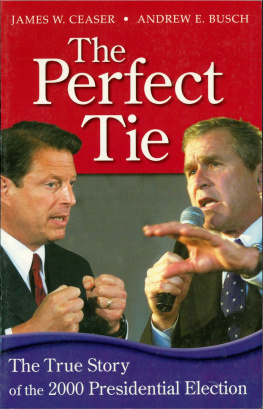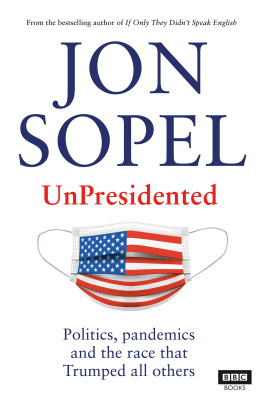Praise for Unstable Majorities
In Unstable Majorities Fiorina makes a series of very important arguments about the American electoral process and the role of the public in it. Although completed not long after the election, Fiorina is able to offer early wisdom about the Trump election and the Trump era. The public, he demonstrates, has long been and continues to be basically moderate in its ideological and policy views. The public votes with high degrees of consistency in large part because the parties so consistently select the same kinds of candidatesliberal Democrats facing off against conservative Republicans. Given the same alternatives, the public tends to vote the same from election to election. Trumps victory, in his view, was essentially continuous with the series of elections in the twenty-first century. In net, only a small proportion of the electorate changed its choices from 2012 to 2016. It is the nature of simple majority rule that, in reasonably close contests, yields the vast changes we observe, such as between Trump and Obama.
John Aldrich, Pfizer-Pratt University Professor of Political Science, Duke University
In this impassioned yet scholarly book Fiorina explores the instability that has resulted in recent American politics, as a generally moderate and conflicted electorate has been forced to choose among options served up to them by increasingly polarized political parties and activists. The paradox is that voters increasingly follow the party line but that political outcomes have become wildly oscillating and unpredictable. As Fiorina explains we can only understand voters in the context of the choices they face.
Andrew Gelman, Professor, Department of Statistics and Department of Political Science, Columbia University
Few, if any, write as clearly and persuasively about politics as Mo Fiorina. Many will pick up this book thinking that polarization in the electorate is as obvious as the fact that the sun rises in the east, but they will immediately find themselves on their heels. Excellent scholarship causes us to question what we were sure was true, and no one causes us to do that as reliably as Fiorina.
Marc J. Hetherington,Vanderbilt University
Once again Mo Fiorina shows us how institutions matter by reminding readers that voters are only as good as the choices in front of them. The implication in the wake of the 2016 presidential election is important: voters havent failed democracy, party leaders have failed voters. To rehabilitate the reputation of voters in America, political elites must recruit and nominate candidates worthy of being chosen who, once elected, may actually reflect the positions of most votersnear the middle. Unstable Majorities is a classic Fiorina antidote to the hysteria of cable news and the panic among those who tend only to talk to others just like themselves.
Lynn Vavreck, PhD, UCLA Political Science & Communication Studies
Here Fiorina zeroes in on the most significant and distinctive features of the contemporary US political landscape: tenuous party control of government, nationalized elections, and dissatisfied voters. The book is highly readable, rich with insight, packed with concise figures and data, and likely to interest broad audiences inside and outside academia.
Frances Lee, University of Maryland
Are Americans and their political parties highly polarized? Fiorina set off a great debate over this question in Culture Wars? Now, after an intervening decade of turbulent politics, he revisits the question in Unstable Majorities. Whether or not you arrive at the same answers about polarization that he does, his thought-provoking analysis is must reading for anyone seriously interested in American politics.
James E. Campbell, author of Polarized: Making Sense of a Divided America.
UNSTABLE MAJORITIES
UNSTABLE MAJORITIES
Polarization, Party Sorting, and Political Stalemate
Morris P. Fiorina
HOOVER INSTITUTION PRESS
STANFORD UNIVERSITY
STANFORD, CALIFORNIA

With its eminent scholars and world-renowned library and archives, the Hoover Institution seeks to improve the human condition by advancing ideas that promote economic opportunity and prosperity, while securing and safeguarding peace for America and all mankind. The views expressed in its publications are entirely those of the authors and do not necessarily reflect the views of the staff, officers, or Board of Overseers of the Hoover Institution
www.hoover.org
Hoover Institution Press Publication No. 685
Hoover Institution at Leland Stanford Junior University, Stanford, California 94305-6003
Copyright 2017 by the Board of Trustees of the Leland Stanford Junior University
All rights reserved. No part of this publication may be reproduced, stored in a retrieval system, or transmitted in any form or by any means, electronic, mechanical, photocopying, recording, or otherwise, without written permission of the publisher and copyright holders.
Efforts have been made to locate the original sources, determine the current rights holders, and, if needed, obtain reproduction permissions. On verification of any such claims to rights in the articles reproduced in this book, any required corrections or clarifications will be made in subsequent printings/editions.
First printing 2017
23 22 21 20 19 18 17 7 6 5 4 3 2 1
Manufactured in the United States of America
The paper used in this publication meets the minimum Requirements of the American National Standard for Information SciencesPermanence of Paper for Printed Library Materials, ANSI/NISO Z39.48-1992. 
Cataloging-in-Publication Data is available from the Library of Congress.
ISBN: 978-0-8179-2115-6 (pbk. : alk. paper)
ISBN: 978-0-8179-2116-3 (epub)
ISBN: 978-0-8179-2117-0 (mobi)
ISBN: 978-0-8179-2118-7 (PDF)
To George P. Shultz,
American statesman, in appreciation of his support.
Contents
List of Figures and Tables
Figures
Tables
Preface
In the spring of 2003, I began to outline an article on then contemporary American public opinion. Unlike most of my writing over the preceding three decades, that effort reflected more than the usual academic concern, namely, that in its coverage of contemporary politics the national media were hurting America, as Jon Stewart would put it sometime later.
Finally, if polarization is defined by reference to the positions held by Americans on specific matters of public policy, the picture was again the same. Even on so-called hot-button issues like abortion, Americans continued to favor something in between the positions of the parties. There was no evidence that they had abandoned the middle and moved toward the policy poles. In particular, colorful but unrepresentative media case studies had greatly exaggerated the differences between the residents of red and blue states. Public opinion data indicated that majorities in red and blue states were nearly always on the same side of issues, although the size of these majorities generally differed.
The planned article expanded into a short book, Culture War? The Myth of a Polarized America, published in the early summer The reason is that the discussion in the book was based on a survey of publicly available data that had not been selected, recoded, or otherwise transformed to support a case. Any undergraduate political science major can replicate the findings reported in the book.
Next page








